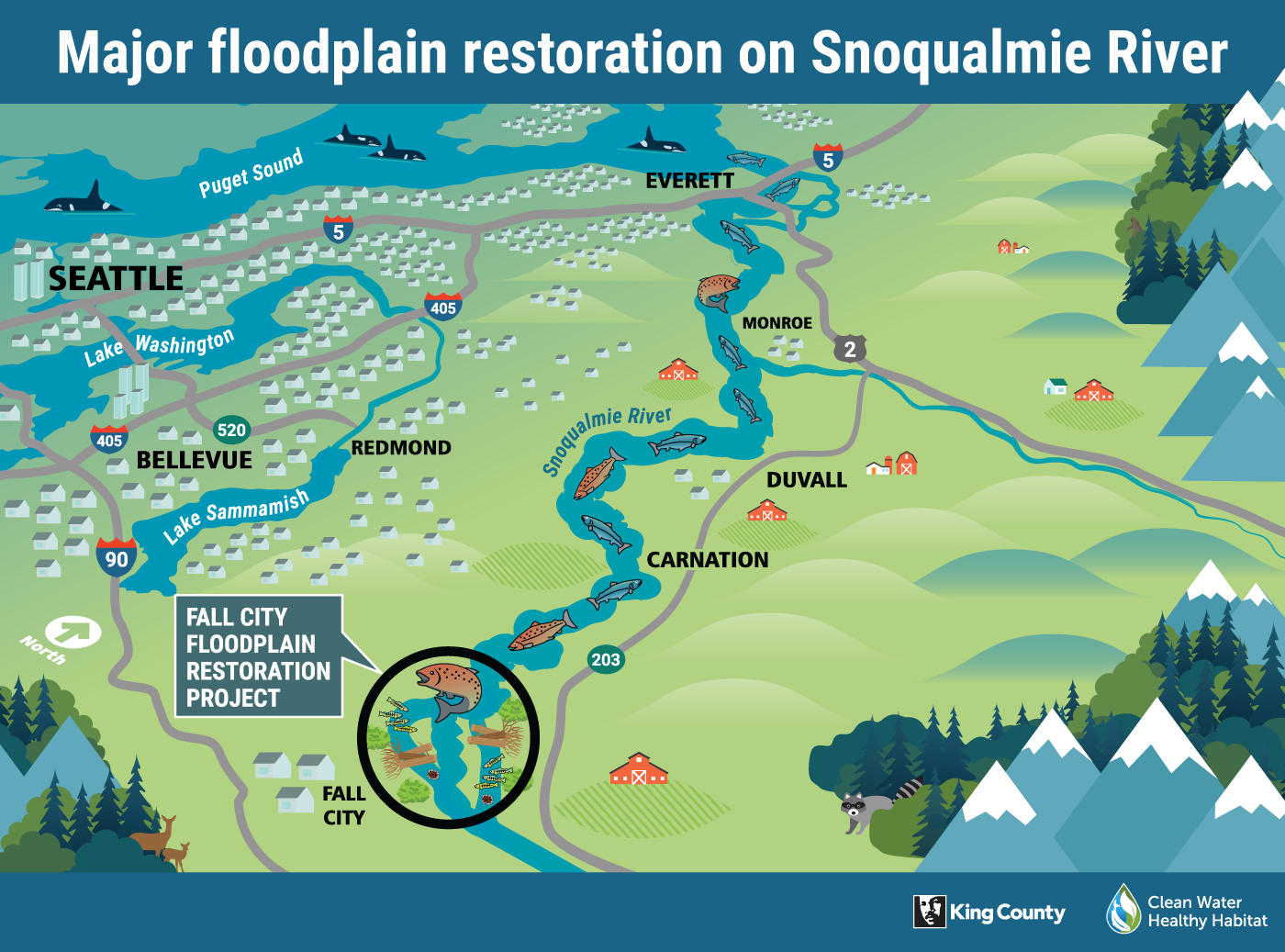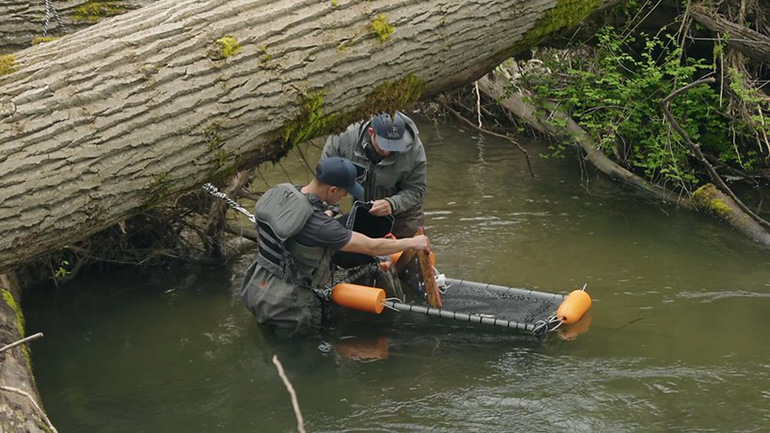Executive Constantine tours King County’s largest-ever floodplain restoration project, improving habitat and protecting farmland along the Snoqualmie River
Summary
King County successfully completed the 145-acre Fall City Floodplain Restoration Project, improving habitat and protecting farmland and homes along the Snoqualmie River.
News
As part of an Earth Week tour of environmental achievements by King County and its partners, Executive Dow Constantine today toured a recently completed floodplain restoration project along the Snoqualmie River that is the largest in the county’s history.
The 145-acre Fall City Floodplain Restoration Project improved habitat and strengthened flood protections for nearby farms, homes, and roads. It is among the first King County-led projects to apply the principles of Snoqualmie Fish, Farm, and Flood, a landmark agreement Executive Constantine signed in 2017 to achieve multiple benefits for restoration projects.
“Our successful restoration of a key section of the Snoqualmie River – the largest project of its kind in King County’s history – builds on progress we have made along major river corridors throughout the region,” said Executive Constantine. “Our employees and partners have improved habitat for salmon and reduced flood risks for people, farmland, and homes, demonstrating our ability to produce multiple benefits for each public dollar we invest.”
Ecologists working to recover salmon populations in the Snoqualmie watershed – among the most productive in the Central Puget Sound region – have long noted the lack of high-quality habitat where young salmon can grow, the result of levees and other structures that were built close to the river’s main channel during the mid-20th century.

The restoration project led by King County’s Water and Land Resources Division removed more than a half mile of levee and other structures to reconnect the Snoqualmie River to its historic floodplain near Fall City. It reconnected one-third of a mile of side channel on the left bank of the river and constructed a half mile of meandering side channel on the right bank.
Crews embedded logs in the historical and new side channels they excavated to add ecological complexity. They installed underground flood protection structures along a newly aligned road that runs along the right bank. Along the left bank, crews installed an earthen berm that protects farmland from increased flood risks while reforesting the area with native plants.
Improving the river’s connections to about 145 acres of its floodplain, including its historical side channels, creates ideal habitat, offering slow-moving, shallow water where small salmon can feed, grow, and hide from predators.
The project was completed this past fall, and biologists have already seen young salmon using portions of the recently restored habitat. Aerial footage during the most recent spawning season showed hundreds of adult pink salmon spawning in the river’s main channel where crews worked.
It is the latest in a series of successful restoration projects King County and its partners have completed in recent years along major river corridors, including the Green River, Cedar River, and Duwamish River.
Continuing to enhance the restoration site, exploring ways to improve for the next project
King County is continuing to enhance the restoration site, controlling invasive weeds and planting native vegetation that creates more diverse, natural habitat after decades of degradation.
Ecologists are conducting a study to assess the growth, diet, and available food supply for salmon at the restoration site. They hold young chinook salmon in enclosures within the river and compare their food intake, growth, and other metrics to that of free-swimming young salmon from the same section of the river. The research – modeled after a study of salmon in the Sacramento River in California – will identify ways King County can improve future floodplain restorations to produce better results for struggling salmon populations.

The $19 million restoration project – including the costs to acquire the property – was funded with a variety of sources, including competitive grants for salmon recovery, flood risk reduction, and agricultural productivity:
- Washington State Recreation and Conservation Office
- Washington State Department of Ecology – Floodplains by Design
- King County Cooperative Watershed Management Grant via the King County Flood Control District
- Surface Water Management Fees
- Snoqualmie Indian Tribe for vegetation planting on a portion of the site
- King County Parks Levy
- King County Conservation Futures Grant
- King County Flood Control District
- Washington State Salmon Recovery Funding Board
Better aligning efforts to produce multiple benefits for each investment is the centerpiece of Clean Water Healthy Habitat, an initiative created by Executive Constantine to achieve better results faster for people, salmon, and orcas.
Multimedia
- PHOTO GALLERY: King County's largest-ever floodplain restoration
- VIDEO: B-roll package available to download
- TRACKS: An interactive map of environmental stewardship in King County
Resources
- Project overview of Fall City Floodplain Restoration
- Snoqualmie Fish, Farm, and Flood
- Clean Water Healthy Habitat
Quotes
Our successful restoration of a key section of the Snoqualmie River – the largest project of its kind in King County’s history – builds on progress we have made along major river corridors throughout the region. Our employees and partners have improved habitat for salmon and reduced flood risks for people, farmland, and homes, demonstrating our ability to produce multiple benefits for each public dollar we invest.
I am honored to join King County Executive Constantine, County staff, and regional partners as we celebrate this critical investment in habitat, farmland, and salmon protection along the Snoqualmie River. By protecting 145-acres through the Fall City Floodplain Restoration Project, we reaffirm our collective commitment to meeting our Climate Action Plan priorities in King County. As Chair of the Local Services and Land Use committee, and as the Council lead on the 10-year comprehensive plan update, it is important to me that we steward our land effectively to strengthen flood protections while furthering initiatives to ensure that our salmon populations thrive in the Snoqualmie Watershed. This is an excellent example of just that, and everyone should be proud of their part in it.
State programs like Puget Sound Acquisition and Restoration Program and Floodplains by Design provide crucial funding that enables local collaborative forums, like the Snoqualmie Watershed Forum, to turn our highest priorities for watershed health and salmon recovery into actions. Projects like the Fall City Floodplain Restoration Project are improving habitat for salmon and giving us hope for recovering our streams and rivers.
Floodplain reconnection projects like this one allow floodwaters to spread out onto the floodplain and to course through side channels, which improves habitat and reduces flooding, benefitting fish, farms, and floods. The strength of Fish Farm Flood is in building relationships across interests, working through conflicts, and staying dedicated to the conviction that if we keep talking and working for the multiple interests of all, we can all thrive.
Contact
Doug Williams, Department of Natural Resources and Parks, 206-477-4543

 Translate
Translate

